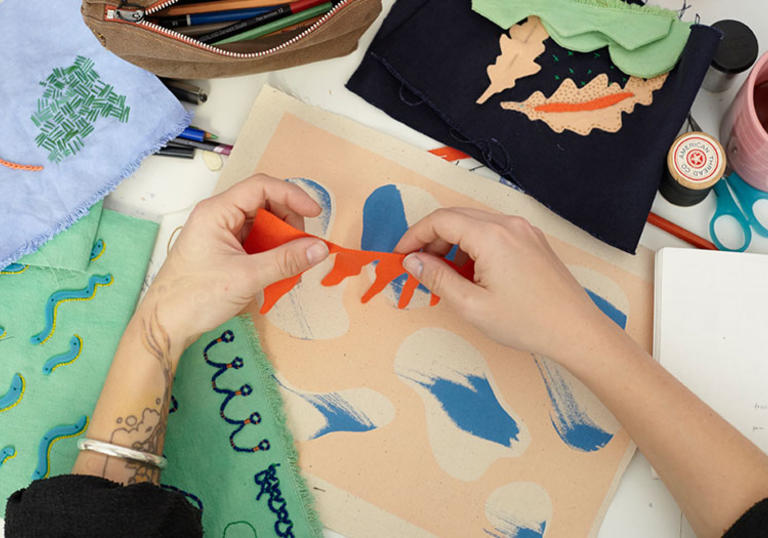Based in East London, Anna’s joyously intuitive approach to pattern and colour are evident across her work. Her vibrant range of ceramics, fabrics and prints are now on exclusive display at the Barbican until March 2017.
We met Anna to find out more about her work, her studio and what we can look forward to from her new Barbican range…
How did you start your career as a ‘maker’?
I’m originally from Baltimore, Maryland. I came over to the UK to study Embroidery at Manchester School of Art, and after graduating spent a few years as a costume maker and art director, working specifically on immersive events that combined music and performance art. I also was making paintings, collages and paper sculptures. Around 2013 I moved down to London, and started exploring ways of making work that would be accessible and allow me to make a living working for myself, but also satisfy my desire to have a studio practice. I do enjoy making stuff that people can use in daily life, and the products I make are all based on paintings and collages.
What does a typical day (if there is one…!) look like in your studio?
I live on a narrow boat, so from the very start of the day that keeps things interesting, because every two weeks my commute to the studio changes as we move around the London canal network. Where ever I’m coming from though, I get in to the studio around 7am, eat breakfast, check emails and generally faff around for a bit, water my plants (I’ve got an ever expanding windowsill nursery of baby plants), that kind of thing. I have two separate spaces where I work, one for textiles, paper, and computer based work, and one for ceramics and other messy jobs (I also freelance as a prop maker). So the majority of my days are spent running between the two spaces. Though really, once I start working on ceramics it’s hard to leave again. Clay seems to have a magnetic pull and someone’s always just put on a really interesting podcast. The ceramics studio is Clay Collective, I’m one of the cofounders of this 12 member coop. We’re about to celebrate the studio’s first birthday, it’s hard to believe we’ve already been in there a year.
What made you apply to be the Barbican Maker?
I was really interested in the way that the initiative was framed almost as more of a commission and collaboration than just an opportunity to be a wholesale supplier. The Barbican shop already has a good reputation for supporting emerging makers and designers, so I had a feeling that if I was selected it might be a good opportunity to try out some new ideas and processes.
Clay seems to have a magnetic pull
Your work is routed in collage and spans textiles, printmaking and ceramics – what can people expect from your commissions for the Barbican?
The work I’ve produced to the Barbican has a little bit of everything, you’ll find tote bags, vases, plant pots, mugs, wallets, greetings cards and prints. We’ve mostly kept the collection based around things that are useful in some way. I’ve created a new fabric print design especially for this commission, which is based on my collages and ceramic sculptures.
One of my favourite pieces for this commission was a ceramic coffee set, which I thought was a good representation of the entire collection in that it was a playful combination of shape and colour, kind of made to be a composition of forms all together, but very much a useful set of objects. It’s already been sold though (I can’t believe it!) so I best get making a new set…
What is your favourite feature of the Barbican?
The architecture of the Barbican is stunning, it’s hard to believe it was once voted London’s ugliest building. I love walking around the centre and the surrounding Barbican Estate and thinking about the kind of utopian visions architects had for urban housing around that time, and how in many cases it didn’t really work out how they envisioned… and so I then start to imagine I’m in the setting a dystopian sci-fi novel. I hope that doesn’t sound like an insult – it’s my favourite genre.
But I also really love the programming at the Barbican, two of my favourite exhibitions to date have been there – Dancing around Duchamp and Bauhaus: Art as Life, both of which I used as inspiration for this commission.
It’s the personal projects you do that will make people take notice
Do you have any advice for artists looking to work in product design?
In a general sense I would say to anyone wanting to work for themselves is collaborate often, and don’t underestimate the power of personal projects.
Working for other people is definitely important in terms of learning skills and meeting like-minded people, but I think that if you’re determined to go your own way, it’s the personal projects you do that will make people take notice, because they’re the ones that are a true representation of your personality and ideas.

